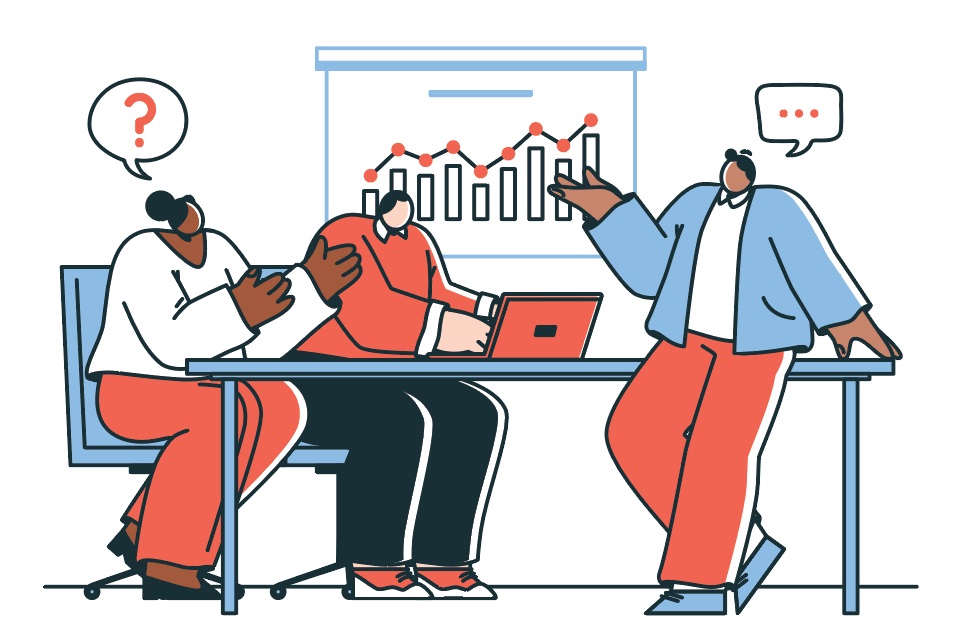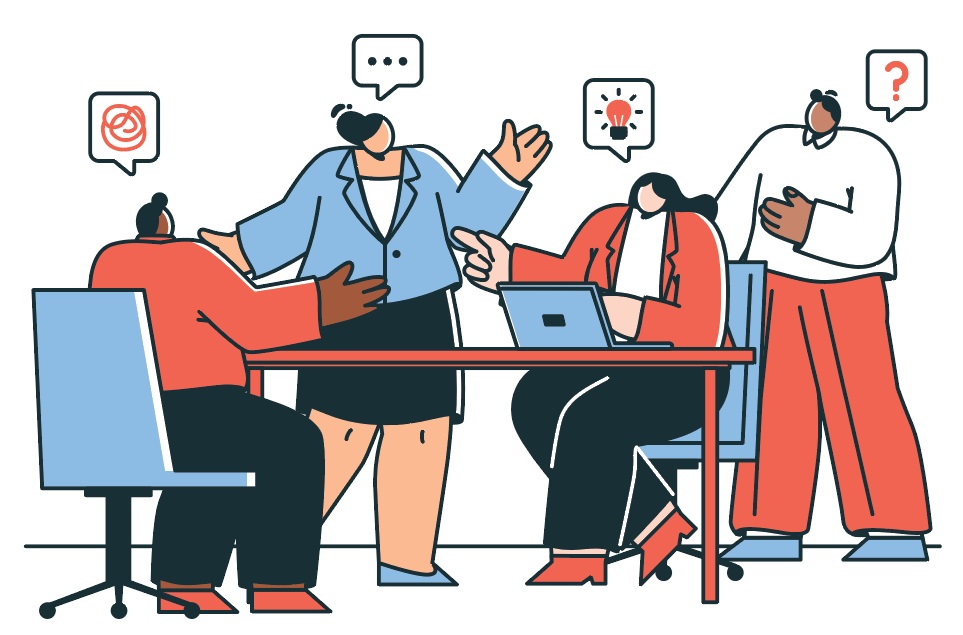By Kate Vitasek
Team members use much different language when describing “good” versus “typical” trading partner relationships. Through assessments, companies can measure and address relationship health, ensuring that trading partner trust remains as strong as possible in order to keep the companies’ goals aligned.
“Mind the gap” is a popular warning for rail passengers when going from one platform to another – but it also applies to trading partner relationships.
When trust has eroded in supplier relationships, companies can find themselves worlds apart. The gap can feel insurmountable, and it can feel like you’re stretching and stepping beyond your comfort zone to maintain the relationship. In fact, there is a massive gap in how organisations feel, and the words used by team members regarding “good” versus “typical” relationships with trading partners.
“Mind the gap” is a popular warning for rail passengers when going from one platform to another – but it also applies to trading partner relationships.
Think of your cherished and respected trading partners, and words like “collaborative” and “trustworthy” might come to mind. A more demanding trading partner, one whose emails or calls make your blood pressure rise, might bring up words like “frustrating” and “difficult”. That language gap is indicative of the frictions and hidden costs that can emerge in trading partner relationships.
By minding the trust gap, companies can ensure that they stay aligned with trading partners, fuelling the bottom line, keeping team members engaged, and allowing organisations to be proactive in maintaining long-term bonds.
How To Measure Trust
A white paper released in April by the University of Tennessee and its research partner, SAP, explored the factors that contribute to and inhibit trust in the energy industry.1
As part of the research, companies that purchase goods or services (buyers) were asked to identify two companies that provide services to them (suppliers). Each buyer was asked to provide a supplier with whom they felt they had a “good” relationship, and one that embodied a more “typical” relationship.
But trust is a fuzzy thing. How do you measure the level of trust in relationships?
The buyers and suppliers completed a compatibility and trust (CaT) assessment, which quantifies relationship health across five dimensions:
Focus is the ability to combine individual roles into a corporate direction to benefit all stakeholders. There is a common purpose and direction and clarity around that direction.
Team orientation is the ability to focus and direct individual goals and objectives into a cohesive group strategy. Team orientation is a key indicator of how well trading partners work together.
Communication is the efficient and effective transfer of meaning through words and actions to achieve and grow mutually beneficial outcomes. It includes open and timely sharing of information relevant to a partner’s decision-making ability.
Innovation is an organisation’s ability to dynamically deal with change, and its tolerance for risk and trying out new ideas and solutions. Strong and trusting relationships allow the parties to share risks and rewards, invest in each other’s capabilities, and embrace continuous improvement and transformation efforts.
Trust is the consistency of performing to promise and meeting commitments. Without performance, trust cannot exist.
The assessment is conducted using a 360-degree “two-world view”, meaning that trading partners provide perspectives and responses about their own organisation along with the other company.
The assessment also contains qualitative, open-ended questions, along with the opportunity for respondents to provide three adjectives to describe the current relationship and the chance to “grade” their perception of the relationship on a scale from 1 to 100, with 1 being “very negative” and 100 being “very positive”.

Loaded Words
The University of Tennessee-SAP study, which involved 34 companies, found that team members working in “good” relationships used mostly positive adjectives (85 per cent) such as “aligned”, “collaborative”, and “trustworthy” to describe their relationship.2 But when team members were describing “typical” relationships, they used positive words much less frequently, only 63 per cent of the time. Instead, they used words like “frustrating”, “restrictive”, and “distant”. And in 9 per cent of cases, they used really negative words, such as “difficult”, “strained”, and even “dysfunctional”.
Measuring The Trust Gap
Why was there such a big difference in the words used? And what does it mean?
It’s far too easy for trading partners to find themselves worlds – and words – apart, and for the trust gap to be ever-widening. One reason for that misalignment is self-serving bias, where respondents in surveys are likely to rate themselves as above average in key areas such as ethics. Buyers and suppliers are likely to view themselves fairly positively and classify their organisation as having a high degree of trust. Such biases can intensify trust gaps between organisations, which in turn could force trading partners to respond in ways that are not advantageous for the partnership. A lack of trust could cause a buyer to increase quality checks, micromanage production outputs, or add buffer stock to inventory.
The CaT assessment takes perception gaps between the parties into account through an “index” score and penalises the partnership as the perception gap widens. Unlike one-dimensional or narrow assessment tools, the CaT allows each partner to reflect inward while taking true stock of the relationship and sharing how they really feel. That reflection, while sometimes viewed as awkward, is important in getting partners on the same page, especially if trust has been diminished.
Fading Trust And Yellow Flags
Notably, the research showed that team members sometimes report a sense of frustration even in “good” relationships. For example, in the oil and gas sector, team members used negative adjectives such as “complicated”, “demanding”, and “frustrating” 4.4 per cent of the time, and 1.1 per cent of the time in the utility sector.3
Problems between partners can be insidious, silently eroding trust without either of the partners recognising it, until it becomes a full-blown problem.
When collaborating with a trading partner, even one held in high regard, it’s easy to come across potential sticking points or “yellow flags” that pose the potential for undermining or eroding the relationship over time. Communication delays, quality issues, or late payments, for example, could raise a buyer’s concern or make them pursue outside arrangements with other companies. Problems between partners can be insidious, silently eroding trust without either of the partners recognising it, until it becomes a full-blown problem. The trust gap can widen without either partner giving it much notice. Maintaining buyer-seller trust requires vigilance and the ability to look inward.
Major Warning Signs

With “typical” relationships, meanwhile, team members were lukewarm to negative about their trading partner almost 40 per cent of the time – a figure that represents a major warning sign.
Companies have hundreds, if not thousands, of trading partner relationships. If almost 30 per cent of these typical relationships are considered frustrating, restrictive and distant, and 9 per cent of these are downright bad, think about what that means for a “bad” relationship!
The Hidden Costs Of Trading Partner Relationships
The hidden costs of trading partner relationships can pile up quickly. Trust can shift to distrust, and that distrust can come through in friction, delays, lapses, and restrictions.
Friction in a trading partner relationship has a name: “transaction cost economics” (TCE).
When you have a trading partner that is frustrating to deal with, the time and cost associated with dealing with that partner go up. Such frustrations can cause team members to check out and become disengaged, creating a ripple effect with deep impacts not just for the relationship between trading partners, but for your own company.
When trust is diminished between parties, participants pull back and become more focused on “what’s in it for me?”, instead of finding win-win solutions. Distrust becomes like an insidious weed in a garden, and a growing sense of it can make companies and team members less trusting in other relationships. In essence, a loss of trust means a loss of happiness. How can the trading partners get back on the same page?
Improving The Trust Gap
One of the most impactful turnarounds in rebuilding relationship partner trust through the CaT involves Vancouver Island Health Authority (VIHA) and a group of doctors (South Island Health Incorporated), who were operating under a labour services agreement for providing hospitalist services to VIHA.
When team members first took the CaT, their initial Index was .48, which was measured as “unhealthy”. The trust between the parties was damaged.4 In describing the relationship, participants frequently used the words “strained”, “distrustful”, “broken”, and “dysfunctional”. Negative adjectives were used 84 per cent of the time, whereas fewer than 10 per cent of the adjectives used were positive.
But the assessment provided tangible guidance on what was causing the companies’ trust
Issues, and the parties made a conscious choice to bring more trust and collaboration to the relationship. Those efforts helped VIHA and the doctors to increase their CaT index to .71 in only two years. And in describing their once-troubled relationship, the partners used words such as “collaborative”, “respectful”, “trusting”, “supportive” and, yes, even “happy”.
Just how happy? The words used had gone from 84 per cent negative to 86 per cent positive!

The Bottom Line
By taking stock of the way trading partners view one another, and taking stock of how they are viewed by others, companies can focus on getting back on the same page and finding common ground to keep their goals aligned.
The bottom line? By minding the trust gap – not sugar-coating matters, not ignoring partner concerns, but being completely open to whatever emerges in the assessment – companies can explore and address the issues holding back their trading partnerships.
About the Author
 Kate Vitasek is a world authority on highly collaborative win-win relationships for her award-winning research and Vested business model. Author of seven books and a faculty member at the University of Tennessee’s Haslam College of Business, she has been featured on CNN International, Bloomberg, NPR, and Fox Business News for her insights on how to create highly collaborative win-win strategic business relationships.
Kate Vitasek is a world authority on highly collaborative win-win relationships for her award-winning research and Vested business model. Author of seven books and a faculty member at the University of Tennessee’s Haslam College of Business, she has been featured on CNN International, Bloomberg, NPR, and Fox Business News for her insights on how to create highly collaborative win-win strategic business relationships.
References
-
Kate Vitasek and Karl Manrodt. “Unpacking Trading Partner Trust in the Energy Industry”. University of Tennessee and SAP, April 2024, https://www.vestedway.com/wp-content/uploads/2024/05/Unpacking-Trading-Partner-Trust-in-the-Energy-Industry-Apr-9-2024.pdf.
-
Ibid.
-
Ibis.
-
Kate Vitasek, Karl Manrodt, Fredrik Nikolaev, Andrew Downard, and Jerry Ledlow. “Unpacking Trading Partner Trust”. University of Tennessee and SAP, October 2022, https://www.vestedway.com/wp-content/uploads/2022/11/Unpacking-Trading-Partner-Trust-Oct-2022.pdf.


![shutterstock_769822945-3[Converted] Mind the Trust Gap. Partner in business shaking hands](https://www.europeanbusinessreview.com/wp-content/uploads/2024/07/shutterstock_769822945-3Converted-696x522.jpg)

































